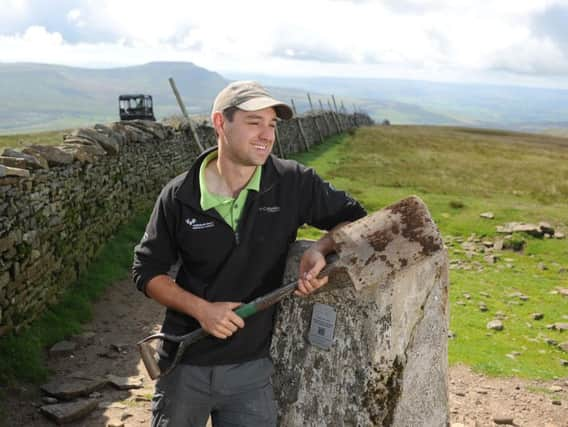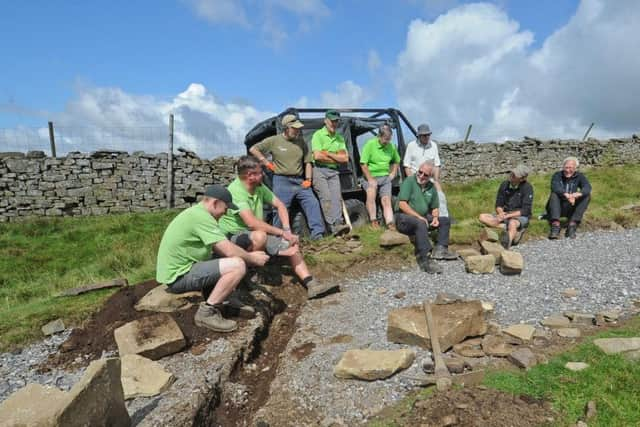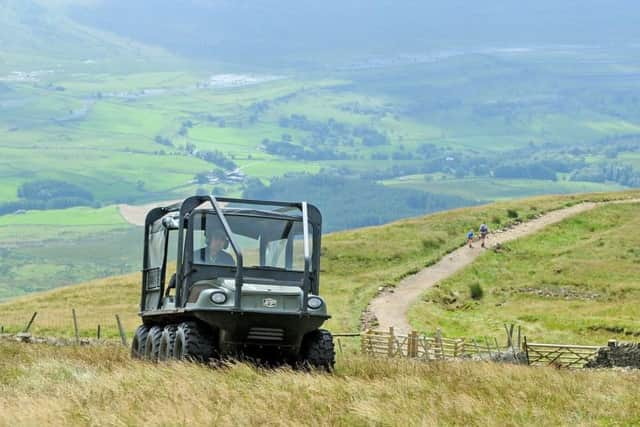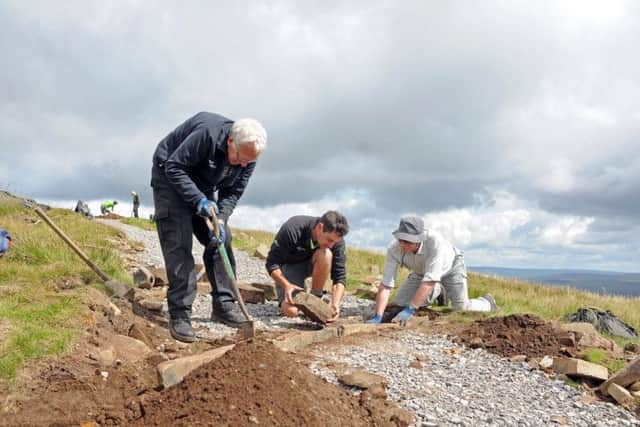How dedicated rangers help to maintain beauty of Yorkshire Dales National Park


The moon waxing bright... A horse and rider tumbling in an icy lane. Chances were that Jane Eyre would never have met Byronic anti-hero Edward Rochester in such melodramatic circumstances if the Yorkshire Dales National Park Authority (YDNPA) ranger service had been operating in Victorian times.
“Fair comment?” I ask Josh Hull in the YDNPA’s Stainforth office, this being a barn fitted with desks, computers and a kettle – plus ranger tools like wheelbarrows and sledge-hammers.
Advertisement
Hide AdAdvertisement
Hide Ad“I mean,” I add, “rangers would have repaired drains, so giving less chance of ice forming on Charlotte Brontë’s Hay Hill lane. No falling horse, no swearing, no sprained leg.”


Josh laughs. “Sounds about right. If a bridleway needs mending, we repair it; ditto the rest of the 1,600 miles of YDNP public footpaths, bridleways and byways.”
This is what it's like to work as a ranger in the Yorkshire Dales National ParkThey also maintain a number of the iconic trails that pass through the national park: the Pennine Way, Pennine Bridleway, Dales Way, Coast to Coast Walk, the Three Peaks.
“That’s our own area of expertise, the Three Peaks. Pedestrian counters I recently installed indicate at least 100,000 walkers a year top Whernside, Ingleborough and Penyghent.”
Advertisement
Hide AdAdvertisement
Hide AdThat’s some wear-and-tear underfoot. “Thousands of cleaned boot soles can tramp the ground into a treacherous quagmire. Heavy rainfall gouges out unsightly gullies that are visible for miles.”


As one of seven YDNPA rangers in the southern part of Yorkshire’s National Park (plus three apprentice rangers), Josh offers additional hands-on support to farmers, land managers, parish councils and local groups.
The Yorkshire Dales has been named on a Lonely Planet list of the best British experiencesCalm and collected, he appears to be an ideal ranger; friendly, approachable and able to keep his cool. When he spots dogs spooking sheep, he moderates his censure when reprimanding the owners.
There are more than 200 ranger-volunteers across the Park with 80 or so volunteers in this southern team. “It’s the volunteers who give us more power to our elbow – from newbies to veterans,” says Josh.
Advertisement
Hide AdAdvertisement
Hide AdVolunteers provide the much-needed assistance over the 841 square miles of the YDNP, including Open Access Land where ranger teams work with landowners to improve access.


“Ranger-volunteers are solid gold. Duke of Edinburgh Award students, for example, can help with a day’s landscaping. The Army Apprentice College at Harrogate sends groups to assist us. I helped alongside 50 cadets working on Gordale Scar last year. “If the volunteers are newbies, we teach them.
"An old saying goes, ‘There’s some you show, some you ask and some you tell.’ I mean, ranger-volunteers even advise me when they’ve experienced similar conditions and I’m
struggling.”
Rangers are typically involved with managing public rights of way, maintaining signs, bridges, stiles, gates, stepping stones and erosion repair projects.
Advertisement
Hide AdAdvertisement
Hide AdThey also work with local communities and schools from within and outside the national park.
As if on cue, four YDNPA volunteer-rangers join us. Graeme Smith is a retired GP from St James’ Hospital, Leeds. Jane Timperley from Bingley, Mark Kerr from Airton and Mike Pinder of Barnoldswick are also all retired; respectively, a former community nurse, an IT specialist and an ex-town planning officer.
“I’m a newbie,” says Graeme. “Been a volunteer for a year. What made me swap my stethoscope for a shovel?” He laughs. “Good question. It was, I’d say, to give something back to a beautiful area which has helped me unwind for 30 years.”
The old Yorkshire Dales station that will become a businessman's private hobby railwayFellow trainee, Mark Kerr who worked in Leeds in IT for many years before moving to Airton, agrees. “More people want to be volunteers than the YDNPA has vacancies for. Applicants fill in a form. Then comes a practical session. Graeme and I spent an afternoon shovelling gravel along a footpath near Threshfield.”
Advertisement
Hide AdAdvertisement
Hide AdJane Timperley began volunteering about two years ago after nursing in the Silsden and Ilkley area. “I’ve been told I have green fingers and helped renovate the garden at Cove End in Grassington, one of the two main offices in the national park.”
A ranger-volunteer for five years, Mike Pinder was a town planning officer in Wakefield prior to moving to Barlick to be nearer the Dales. Volunteering appealed. Like the others he has tramped the 24-mile Three Peaks walk.
Last but not least, Josh, began work as a YDNPA apprentice in 2010 after leaving school in Settle. He was appointed as a ranger in 2013.
“I’ve always lived in the middle of nowhere,” he says. “Like in an old converted farmhouse in Keasden, above Clapham. I love being outdoors among our volatile weather. Making paths sustainable, easier to use and to be enjoyed by as many people as possible, that’s my passion.
Advertisement
Hide AdAdvertisement
Hide Ad“We try to encourage people to keep on the paths and not stray off them, because it can cause unsightly erosion scars that rain helps deepen if not dealt with quickly.”
Airton-based Mark Kerr chips in: “I did the Three Peaks walk in 1985 and remember walkers on Pen-y-ghent who had hired guides.
“Near the summit gullies caused by rain and boots were sometimes 4ft deep. The guides carried poles that their clients could grab if they felt themselves sinking.”
Duckboards – now long gone – were once also used to guide walkers up Pen-y-ghent.
Advertisement
Hide AdAdvertisement
Hide AdThey’ve been replaced by a woven plastic which “floats” on wet soft ground, and presents amenable walking terrain when topped with a layer of aggregate. Erosion scars 60 feet wide in places on Ingleborough, he says, required different treatment. Basically 200ft of flagged path was airlifted by helicopter on to the summit slopes, the project being partnered by the British Mountaineering Council (BMC).
The ranger team used diggers and tracked dumpers for the flagstone laying which added to the 1,000ft previously built on the flanks of Ingleborough by the contractors.
Josh and his ranger-volunteer team then dug up turves, re-seeded the area with grass and landscaped the rugged ground. “I can’t complain, getting flown to work and back in a day, beats walking.”
Further airlifting followed more recently on a second BMC Mend Our Mountains partnership project. Directly across the valley, this involved repairing the heavily damaged Bruntscar path on the steepest flanks of 2,415ft Whernside.
Advertisement
Hide AdAdvertisement
Hide AdAround 130 tonnes of Greywacke gritstone donated by Ingleton Quarry owner Hanson UK did the trick. Airlifted to the site high above Chapel-le-dale by helicopters, contractors from the Highlands rebuilt the stone pitching on 900ft of badly eroded path.
Josh and ranger-volunteer teams complemented the renovated path where stones are pieced together like a jigsaw puzzle – by landscaping its borders.
Not only did the resulting path become more secure for the many walkers passing that way, it also created an added bonus, says Josh. “Our work helped heal the aesthetically and ecologically damaging scarring which had developed across the slope as the path crumbled.”
Finally, the team loaded up a pickup truck with tools for the day’s work – replacing a kissing gate in Kingsdale with a new double-gated version. In a trailer behind is an all-terrain eight-wheeled drive buggy that can cope with all kinds of conditions.
Advertisement
Hide AdAdvertisement
Hide Ad“Its low pressure impact tyres do less damage on boggy ground,” says Josh. “And it has a full canopy that zips up and gives us shelter at brew time if hail is bombarding down.”
Ranger-volunteers experience lots of sensory bombardment on Whernside.
Fighter jets fly so low they skim, thundering under their boot soles; chartered steam trains have train spotters training their cameras on the Settle-Carlisle railway’s Ribblehead Viaduct below; walkers comment as they drop coins in a bucket by the path.
Things like “Digging for gold?” and “Full marks, guys. Have a beer on me.” And the quirkiest question? “When’s the stairlift going in?”